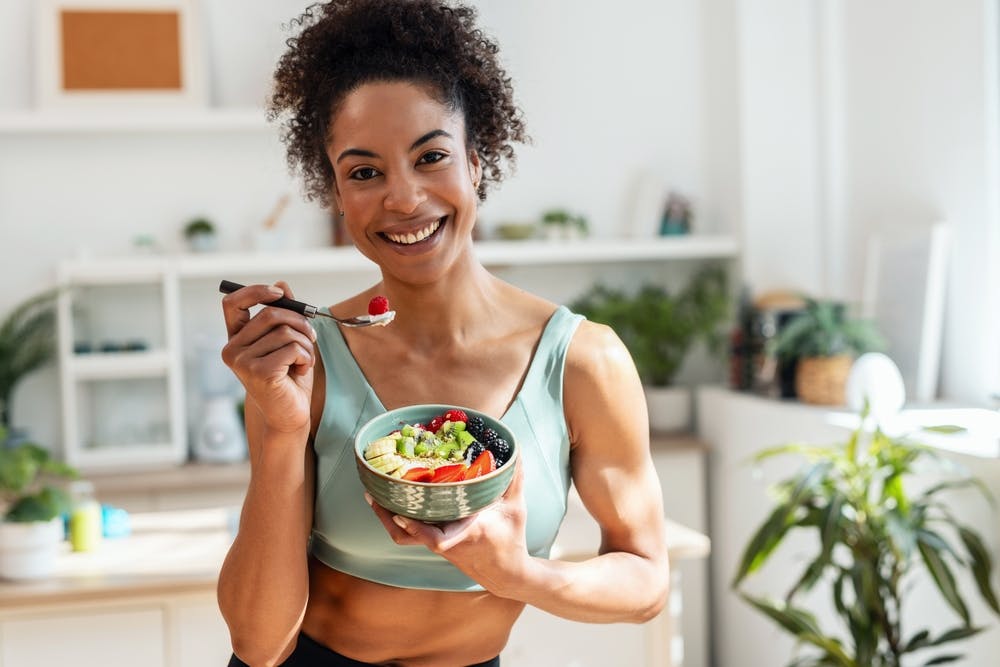Achieving Your Summer Body Goals with the Right Diet and Exercise: A Complete Guide
By Lilian E.
Reviewed by Kenya Bass, PA-C
Published Apr 7, 2025
Updated Apr 17, 2025
8 min read

Summer is the perfect time to feel confident, energized, and proud of your physique. However, transforming your body requires more than just good intentions—it demands a strategic, science-backed approach that combines optimal nutrition with effective training.
If you're reading this, I'm going to assume that you have a summer body goal. Maybe it's hitting the beach with your bikini, debuting your abs in the hot summer heat, or like many just a figure of speech to describe your health and fitness goals.
Whatever your reasons are, there's no better time than now to make a commitment to the life you want and take control of your health for good. Whether you're looking to gain muscle or lose weight. While we know it's not always easy, we've got some interesting tips on how to eat right, exercise smartly, and make sure that you're getting everything you need to help you actualize that summer body goal.
This comprehensive guide will walk you through every step needed to achieve your summer body goals, whether you want to lose fat, build muscle, or simply tone up.
General Summer Body Tips
1. Define Success
First, you'll want to start by choosing a goal that's realistic for you. If you're starting from scratch, it's going to take some time and effort. But if you already have a good base of fitness under your belt, then making small changes will help speed up the process.
Once you've defined what success looks like for you, start tracking your progress each week by measuring yourself and taking photos of yourself from different angles (front, side, back). This is an easy way to see how much progress you've made over time—and if it's not enough for your liking yet.
Get organized! Plan out your meals each day so that you know exactly what you're eating. If it's easier for you to follow a set meal plan, then do that. If not, write down what you intend to eat each day and make sure it fits within your calorie intake goals.
2. Be consistent
Stick with your plan for at least a month before making any changes or adding new exercises or diets. Consistency is key when trying to change habits or routines—if you're inconsistent in any way during this process, it will be much harder for you to reach your goals!
3. Find some inspiration
There are tons of people out there who've already done what you want to do—whether that's losing weight or building muscle—so find them online or in-person and learn from them!
4. Focus on health, not weight
It may sound counterintuitive, but focusing on weight loss is not the right way to go about this. It's not a good indicator of health or fitness. If you want to be healthier, that means you should focus more on how your body reacts and functions than what number comes up on the scale.
The first step in achieving your summer body goals is understanding why weight loss isn't actually a good measure of health—or fitness for that matter!
5. Don't be obsessive about it
It's easy to get caught up in what other people are doing, but you have to remember that they're not you. You have your own goals and they might not be the same as someone else's. Don't compare yourself or feel like you need to do more than anyone else.
Also, don't worry about the mirror or what other people think of you when it comes to working out. The only thing that matters is being healthy and living your best life!
Why Diet and Exercise Must Work Together for Optimal Results
Many people make the mistake of focusing solely on diet or exercise, but the truth is, neither is fully effective alone. A well-structured plan that integrates both is the key to long-term success. Here’s why:
The Critical Role of Diet in Body Transformation
Your diet is the foundation of your results. No matter how hard you train, poor nutrition will hold you back. Here’s how diet impacts your progress:
- Energy & Performance: Eating the right balance of macronutrients (protein, carbs, and fats) fuels your workouts, helping you train harder and recover faster.
- Fat Loss vs. Muscle Retention: A calorie deficit is necessary for fat loss, but without proper nutrition, your body may burn muscle instead of fat.
- Hormonal Balance: Nutrient deficiencies can disrupt hormones like leptin (hunger control) and cortisol (stress hormone), making fat loss harder.
- Inflammation & Bloating: Processed foods, excess sodium, and dehydration can cause water retention, masking your progress.
The Essential Role of Exercise in Shaping Your Physique

Exercise isn’t just about burning calories—it’s about sculpting your body and improving metabolic health. Here’s how it complements diet:
- Boosts Metabolism: Strength training builds muscle, which increases your resting metabolic rate (RMR), meaning you burn more calories even at rest.
- Enhances Fat Loss: High-intensity workouts (like HIIT) trigger EPOC (Excess Post-Exercise Oxygen Consumption), keeping your metabolism elevated for hours.
- Improves Body Composition: Cardio burns fat, but resistance training ensures you lose fat while preserving or even gaining muscle.
- Supports Mental Health: Exercise releases endorphins, reducing stress and emotional eating.
The Powerful Synergy of Diet + Exercise
When diet and exercise are aligned, you experience:
- Faster fat loss (without muscle loss)
- Better workout performance (more energy, strength, and endurance)
- Long-term sustainability (no yo-yo dieting)
- Improved confidence and motivation
The Ultimate Summer Body Diet Plan: What to Eat for Maximum Results
Your diet will make or break your progress. Follow these science-backed nutrition strategies to fuel fat loss while keeping energy levels high.
1. Prioritize Protein to Build Muscle and Stay Full
Protein is the most critical macronutrient for body transformation. It repairs muscle, curbs hunger, and boosts metabolism through thermogenesis (your body burns calories digesting it).
How Much Protein Do You Need?
- Sedentary individuals: 0.6–0.8g per pound of body weight
- Active individuals / Fat loss: 0.8–1g per pound
- Muscle building: 1–1.2g per pound
Pro Tip: Distribute protein evenly across meals (e.g., 30–40g per meal) for optimal muscle synthesis.
2. Load Up on Fiber for Digestion and Fullness
Fiber slows digestion, stabilizes blood sugar, and keeps you full longer—critical for fat loss.
Top High-Fiber Foods
- Vegetables: Broccoli, spinach, Brussels sprouts (4–5g per cup)
- Fruits: Raspberries (8g per cup), apples (4g with skin)
- Legumes: Black beans (15g per cup), lentils (16g per cup)
- Whole Grains: Oats (4g per ½ cup), quinoa (5g per cup)
Avoid: Refined grains (white bread, pasta) which spike blood sugar and increase cravings.
3. Hydration: The Overlooked Key to Fat Loss
Dehydration slows metabolism, increases hunger, and causes bloating.
Hydration Guidelines
- Daily Water Intake: Half your body weight (lbs) in ounces (e.g., 150 lbs = 75 oz).
- Before Meals: Drink 16 oz of water to reduce overeating.
- Electrolytes: Add a pinch of Himalayan salt or lemon to water for better absorption.
Avoid: Sugary drinks, excessive alcohol, and caffeine (which dehydrate).
4. Carb Cycling for Energy and Fat Loss
Not all carbs are bad—timing them strategically maximizes fat loss while keeping energy high.
How to Carb Cycle
- High-Carb Days (Workout Days): 1.5–2g per pound (fuel performance)
- Moderate-Carb Days (Light Activity): 1–1.5g per pound
- Low-Carb Days (Rest Days): 0.5g per pound (enhance fat burning)
Best Carb Sources: Sweet potatoes, brown rice, oats, berries.
5. Healthy Fats for Hormone Balance and Satiety
Fats are essential for hormone production (testosterone, leptin) and joint health.
Best Fat Sources
- Monounsaturated Fats: Avocados, olive oil, almonds
- Omega-3s: Salmon, chia seeds, walnuts
- Saturated Fats (in moderation): Coconut oil, grass-fed butter
Avoid: Trans fats (fried foods, processed snacks).

The Best Workout Plan for a Summer-Ready Body
1. Strength Training (3–4x/Week)
Why? Builds muscle, raises metabolism, and shapes your physique.
2. HIIT for Fat Burning (2–3x/Week)
Why? Burns maximum calories in minimal time.
20-Minute HIIT Routine
- 30s Sprint / 30s Walk (Repeat 10x)
- 40s Burpees / 20s Rest (5 rounds)
- 45s Jump Squats / 15s Rest (8 rounds)
3. Steady-State Cardio (1–2x/Week)
Why? Improves endurance, aids recovery, and burns fat.
Best Options:
- Walking (10,000 steps/day)
- Swimming (low-impact, full-body)
- Cycling (great for leg definition)
4. Core Workouts (Daily, 5–10 Mins)
Why? A strong core improves posture and enhances midsection definition.
5-Minute Core Routine
- Plank (1 min)
- Bicycle Crunches (30s per side)
- Russian Twists (1 min)
- Leg Raises (30s)
Lifestyle Tips to Accelerate Results
- Sleep 7–9 Hours (Poor sleep = higher cortisol = fat storage).
- Manage Stress (Meditation, deep breathing).
- Track Progress (Measurements > scale weight).
Common Mistakes to Avoid
- Crash dieting (slows metabolism).
- Skipping strength training (lose muscle).
- Overtraining (leads to burnout).
Conclusion
It helps to remember that we’re all different, and we all have our own reasons for wanting to get fit. You might be training for a big competition, or you might just want to drop a few pounds before your next vacation.
You need to make sure that you're eating well and working out regularly if you want to see results. It's not enough just to "eat healthily" or "work out"—you need to do both of those things because they work together to help you get a great body.
Whatever your motivation, the tips covered in this article should help you on your journey.
Share this article

Tips for Staying Healthy: 12 Simple Habits for Energy, Longevity, and Better Living
Editorial Team
Sep 30, 202510 min read

Is Eating Before Bed Bad? What Science Really Says About Late-Night Snacking
Editorial Team
Sep 25, 202512 min read

Low Sodium Diet: Simple Guidelines, Food Lists, and Tips for Better Health
Lilian E.
Sep 30, 202512 min read

Best-in-class care is a click away
Find everything and everyone you need to reach your metabolic health goals, in one place. It all makes sense with Meto.
Join Meto